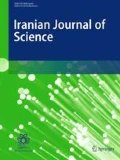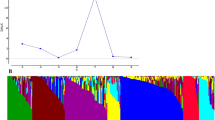Abstract
In current evaluation, the genetic structure and diversity were investigated in ten linseed populations collected from five countries belong to two continents (America and Eurasia) to find different genotypes for introducing them for genetic breeding programs. We selected these populations, because they belong to different regions of Holarctic and Paleotropical phytogeographic kingdoms. For this purpose, the nuclear DNA was extracted using the CTAB-modified method and amplified using 32 ISSR primers. Genetic diversity parameters and polymorphism indexes widely varied among the evaluated populations. Moreover, the results of the analysis of variance test proved the significant genetic differences, which its great part belonged to inter-population rather than intra-population. These findings were consistent with the high GST and HT levels and small amounts of HS and populations grouping in MDS plot, which revealed low amount of within population’s diversity, except those for Arak and Masal populations. In addition, low amount of Nm, indicating a flat rate of gene flow and strong population differentiation. According to the STRUCTURE analysis and UPGMA tree of Nei’s genetic distance, six genotypes were recognized among the studied populations. In the detected genotypes, populations with long geographical distances have the same genetic structure. It seems that the populations with the similar genetic structures have been originated from the same genetic diversity center. Hence, we assume that there are at least six centers of genetic diversity for flax in the world; however, evidences of ancestral gene flow were detected in genetic structure. These findings are consistent with the theory that there are several centers for flax genetic diversity around the world. Due to the high intraspecific diversity in Masal and Arak populations, individuals of these populations have great importance for genetic breeding programs of this species.









Similar content being viewed by others
Data Availability
Data supporting of these findings are available from the corresponding author, upon reasonable request.
References
Ahmed MZS, Masoud IM, Zedan SZA (2019) Molecular characterization and genetic relationships of cultivated flax (Linum usitatissimum L.) genotypes using ISSR markers. Middle East J Agric Res 8(3):898–908
Bibil T, Talat M, Yasin M, Tariq M, Hasan E (2013) Correlation studies of some yield related traits in linseed (Linum usitatissimum L.). J Agric Sci 51:121–132
Bhandari HR, Bhanu AN, Srivastava K, Singh MN, Shreya HA (2017) Assessment of genetic diversity in crop plants an overview. Adv Plants Agric Res 7(3):279–286. https://doi.org/10.15406/apar.2017.07.00255
Chandrawati SN, Kumar R, Kumar S, Singh PK, Yadav VK, Ranade SA, Yadav HK (2017) Genetic diversity, population structure and association analysis in linseed (Linum usitatissimum L.). Physiol Mol Biol Plants 23(1):207–219
Chandrawati SN, Maurya R, Singh PK, Ranade SA, Yadav HK (2014) Diversity analysis in Indian genotypes of linseed (Linum usitatissimum L.) using AFLP markers. Gene 549:171–178. https://doi.org/10.1016/j.gene.2014.07.067
Culley TMM, Wallace LE, Gengler-Nowak KM, Crawford DJ (2002) A comparison of two methods of calculating GST, a genetic measure of population differentiation. Am J Bot 89:460–465
Diederichsen A, Hammer K (1995) Variation of cultivated flax (Linum usitatissimum L. subsp. usitatissimum) and its wild progenitor pale flax (subsp. angustifolium (Huds.) Thell.). Genet Res Crop Evol 42:262–272
Doyle JJ, Doyle JL (1990) Isolation of plant DNA from fresh tissue. Focus 12:13
El Sayed AA, Ezzat SM, Mostafa SH, Zedan SZ, Abdel-Sattar E, El Tanbouly N (2018) Inter simple sequence repeat analysis of genetic diversity and relationship in four Egyptian flaxseed genotypes. Phcog Res 10:166–172
Evanno G, Regnaut S, Goudet J (2005) Detecting the number of clusters of individuals using the software STRUCTURE: a simulation study. Mol Ecol 14(8):2611–2620
Freeland JR, Kirk H, Peterson SD (2011) Molecular Ecology, 2nd edn. Wiley-Blackwell, UK
Fu YB( 2005) Geographic patterns of RAPD variation in cultivated flax. Crop Sci 45:1084–1091
Fu YB, Guerin S, Peterson GW, Diederichsen A, Rowland GG, Richards KW (2003) RAPD analysis of genetic variability of regenerated seeds in the Canadian flax cultivar CDC Normandy. Seed Sci Technol 1:207–211
Jost L (2008) GST and its relatives do not measure differentiation. Mol Ecol 17:4015–4026
Harlan JR (1971) Agricultural origins: centers and non-centers. Science 174:468–474
Hoque A, Fiedler JD, Rahman M (2020) Genetic diversity analysis of a flax (Linum usitatissimum L.) global collection. BMC Genomics 21:557. https://doi.org/10.1186/s12864-020-06922-2
Kumar S, Ram S, Chakraborty M, Ahmad E, Verma N, Lal HC, Prasad Y, Kumar K, Bhushan S, Choudhary AK( 2019) Role of genetic variability for seed yield and its attributes in linseed (Linum usitatissimum L.) improvement. J Pharmacogn Phytochem 266–268
Kumari A, Paul S, Sharma V (2017) Genetic diversity analysis using RAPD and ISSR markers revealed discrete genetic makeup in relation to fibre and oil content in Linum usitatissimum L. genotypes. Nucleus. https://doi.org/10.1007/s13237-017-0206-7
Li D, Yadong Z, Chao L, Tu S, Li M (2009) Optimization of SRAPPCR reaction system in flax. J Northeast Agric Univ 16:17–22
Meirmans PG (2012) AMOVA–based clustering of population genetic data. J Heredity 103(5):744–750
Newell MA, Cook D, Tinker NA, Jannink JL (2010) Population structure and linkage disequilibrium in oat (Avena sativa L.), implications for genome-wide association studies. Theor Appl Genet 122:623–632
Pagnotta MA (2018) Comparison among methods and statistical software packages to analyze germplasm genetic diversity by means of codominant markers. J Multidiscip Res 1:197–215. https://doi.org/10.3390/j1010018
Patial R, Paul S, Sharma D, Sood VK, Kumar N (2019) Morphological characterization and genetic diversity of linseed (Linum usitatissimum L). J Oilseeds Res. 36(1):8–16
Peakall R, Smouse PE (2006) GENALEX 6: genetic analysis in Excel. Population genetic software for teaching and research. Mol Ecol Notes 6:288–295
Rahman MA, Thomson MJ, Shah-E-Alam M, de Ocampo M, Egdane J, Ismail AM (2016) Exploring novel genetic sources of salinity tolerance in rice through molecular and physiological characterization. Ann Bot 117:1083–1097. https://doi.org/10.1093/aob/mcw030
Rana MK, Singh S (2017) Assessment of genetic diversity and DNA profiling of linseed (Linum usitatissimum subsp. usitatissimum L.) germplasm using SSR markers. J Plant Biochem Biotechnol. https://doi.org/10.1007/s13562-016-0391-5
Simmons CA, Turk P, Beamer S, Jaczynski J, Semmens K, Matak KE (2011) The effect of a flaxseed oil enhanced diet on the product quality of farmed brook trout (Salvelinus fontinalis) fillets. J Food Sci 76:S192–S197
Sharifnia F, Assadi M (2001) Flora of Iran, No. 34: Linaceae. Res Inst For Rangel Minist Jahad-eSazandegi Iran
Smỳkal P, Bačova´-Kerteszova N, Kalendar R, Corander J, Schulman AH, Pavelek M (2011) Genetic diversity of cultivated flax (Linum usitatissimum L.) germplasm assessed by retrotransposon-based markers. Theor Appl Genet 122:1385–1397
Soto-Cerda BJ, Diederichsen A, Ragupathy R, Cloutier S (2013) Genetic characterization of a core collection of flax (Linum usitatissimum L.) suitable for association mapping studies and evidence of divergent selection between fiber and linseed types. BMC Plant Biol 13:78. https://doi.org/10.1186/1471-2229-13-78
Soto-Cerda BJ, Maureira-Butler I, Munoz G, Rupayan A, Cloutier S (2012) SSR-based population structure, molecular diversity and linkage disequilibrium analysis of a collection of flax (Linum usitatissimum L.) varying for mucilage seed-coat content. Mol Breed 30:875–888
Takhtajan A (1986) Floristic regions of the world. University of California Press, California
Talebi SM, Amini F, Askary M, Farahani S, Matsyura A (2020) Seed morphology and fatty acids composition among Flax populations. Braz J Bot. https://doi.org/10.1007/s40415-020-00601-y
Talebi SM, Farahani F, Sheidai M, Noormohammadi Z (2014) Palynological characteristics of the heterostylous subspecies of Linum mucronatum Bertol. Collect Bot 33(1):51–63
Talebi SM, Sheidai M, Atri M, Sharifnia F, Noormohammadi Z (2015) Genetic diversity and structure analysis of Linum glaucum populations. Environ Exp Biol 13:75–82
Talebi SM, Rezakhanlou R, Matsyura AV (2019) Infraspecific genetic variation and population structure of Salvia nemorosa L. (Lamiaceae) in Iran. Ecol Montenegrina 26:127–136
Tanksley SD, McCouch SR (1997) Seed banks and molecular maps: unlocking genetic potential from the wild. Science 277:1063–1066
Terfa GN, Gurmu GN (2020) Genetic variability, heritability and genetic advance in linseed (Linum usitatissimum L) genotypes for seed yield and other agronomic traits. Oil Crop Sci 5:156–160
Uysal H, Fu YB, Kurt O, Peterson GY, Diederichsen A, Kusters P (2010) Genetic diversity of cultivated flax (Linum usitatissimum L.) and its wild progenitor pale flax (Linum bienne Mill.) as revealed by ISSR markers. Genet Resour Crop Evol 57:1109–1119. https://doi.org/10.1007/s10722-010-9551-y
Vavilov NI (1951) The origin, variation, immunity and breeding of cultivated plants. Chron Bot 13:1–366
Vos PG, Paulo MJ, Voorrips RE, Visser RGF, van Eck HJ, van Eeuwijk FA (2017) Evaluation of LD decay and various LD-decay estimators in simulated and SNP-array data of tetraploid potato. Theor Appl Genet 130(1):123–135
Vromans J (2006) Molecular genetic studies in flax (Linum usitatissimum L.). Ph.D. Thesis, Wageningen University, The Netherlands
Yan W, Li J, Zheng D, Friedman C, Wang H (2019) Analysis of genetic population structure and diversity in Mallotus oblongifolius using ISSR and SRAP markers. Peer J 7:e7173. https://doi.org/10.7717/peerj.7173
Zeven AC, de Wet JMJ (1982) Dictionary of cultivated plants and their regions of diversity. Centre for Agricultural Publishing, Wageningen
Žiarovská J, Ražná K, Senková S, Štefúnová V, Bežo M (2012) Variability of Linum usitatissimum L based on molecular markers. ARPN J Agri Biol Sci 7:50–58
Zohary D, Hopf M (2000) Domestication of plants in the old world: the origin and spread of cultivated plants in West Asia. Oxford University Press, Oxford, Europe and the Nile Valley
Funding
The authors received no financial support for this evolution, authorship and publication of the paper.
Author information
Authors and Affiliations
Contributions
SMT designed the study and contributed to perform analyses and wrote the manuscript. AM contributed to analysis of data and revise the manuscript critically. All the authors review and approved the final version of the paper.
Corresponding author
Ethics declarations
Conflict of interest
The authors declare that there is no conflict of interest.
Consent for Publication
I (Seyed Mehdi Talebi) hereby declare that I participated in this research and in the development of the paper. I have read its final version and give my consent for this paper to be published in the journal.
Rights and permissions
About this article
Cite this article
Talebi, S.M., Matsyura, A. Genetic Structure of Some Iranian, New and Old Worlds Linum Usitatissimum L. Populations. Iran J Sci Technol Trans Sci 45, 1143–1153 (2021). https://doi.org/10.1007/s40995-021-01074-8
Received:
Accepted:
Published:
Issue Date:
DOI: https://doi.org/10.1007/s40995-021-01074-8




